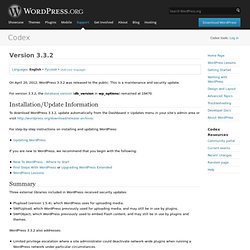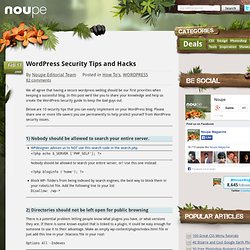

Version 3.3.2. Version 3.3.2 Languages: English • Русский • (Add your language) On April 20, 2012, WordPress 3.3.2 was released to the public.

This is a maintenance and security update. For version 3.3.2, the database version (db_version in wp_options) remained at 19470. Installation/Update Information To download WordPress 3.3.2, update automatically from the Dashboard > Updates menu in your site's admin area or visit For step-by-step instructions on installing and updating WordPress: Updating WordPress If you are new to WordPress, we recommend that you begin with the following: Summary Three external libraries included in WordPress received security updates: Plupload (version 1.5.4), which WordPress uses for uploading media.
WordPress 3.3.2 also addresses: Limited privilege escalation where a site administrator could deactivate network-wide plugins when running a WordPress network under particular circumstances. A full log of the changes made for 3.3.2 can be found at List of Files Revised. Wordpress: 10 trucs simples pour protéger votre blogue. Si vous avez choisi de gérer vous-même l’installation et l’administration de votre blogue, vous devez aussi vous préoccuper de la sécurité.

Aussitôt que votre blogue est en ligne, il peut devenir une cible pour les hacker. Il existe quelques trucs simples qui vous permettront de mieux sécuriser votre installation de WordPress. L’idée de ce billet m’est venu en lisant le billet de Dievochka. Il a été hacké il y a quelques jours et l’expérience n’a pas été vraiment intéressante. Voici donc quelques trucs et réflexions qui vous permettrons de mieux sécuriser votre blogue. 1- La première chose à faire et Dievochka le souligne dans son billet: il faut mettre à jour son blogue. 2- Vous devez aussi mettre à jour vos extensions (plugin). 3- Supprimer les plugins inactifs. 4- Pour vos accès à l’interface administrateur et à la base de données. 5- Désactiver le compte admin ou du moins modifier son rôle. 6- Faites des sauvegardes régulières de votre base de données.
Secure your WordPress website. Security is important, but oftentimes it’s forgotten about when it’s a personal blog or a pet project.

Take some time this week and ensure the future of your WordPress site. There are a couple of quick ways you can better lock down and secure your site, using Plugins. Protect your login First, grab Login Lockdown, a Plugin that safeguards your WordPress login screen. There are a few settings, but the basic settings will get you pretty far. Protect your WordPress files Secondly, set up WordPress File Monitor. Backup your files, just in case Finally, set up a backup process. Check out the Plugins BackupBuddy or VaultPress. For more security tips If you’d like to spend more time improving your site’s security, you can read our more in depth blog post 12 Clever Tips for Securing Your WordPress Site. Do you follow these, or similar tips for securing your WordPress site? Wordpress Security Tips and Hacks.
Feb 17 2008 We all agree that having a secure wordpress weblog should be our first priorities when keeping a successful blog.

In this post we’d like you to share your knowledge and help us create the WordPress Security guide to keep the bad guys out. Below are 10 security tips that you can easily implement on your WordPress blog. Please share one or more life-savers you use permanently to help protect yourself from WordPress security issues. 1) Nobody should be allowed to search your entire server. WPdesigner advices us to NOT use this search code in the search.php<? 2) Directories should not be left open for public browsing There is a potential problem letting people know what plugins you have, or what versions they are. Options All -Indexes 3) Drop the version string in your Meta Tags This tag is in the header.php file that displays your current version of wordpress. 4) Protecting your WordPress wp-admin folder 5) Stay up to date 6) Take regular backups of your site and Database Homepage.